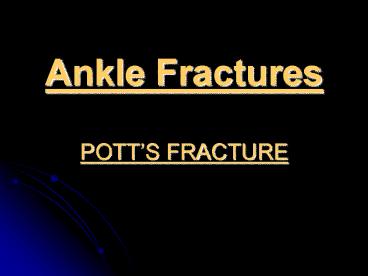Ankle Fractures POTT - PowerPoint PPT Presentation
1 / 14
Title:
Ankle Fractures POTT
Description:
Ankle Fractures POTT S FRACTURE Malleolar Fractures Injuries about the ankle joint cause destruction of not only the bony architecture but also often of the ... – PowerPoint PPT presentation
Number of Views:288
Avg rating:3.0/5.0
Title: Ankle Fractures POTT
1
Ankle FracturesPOTTS FRACTURE
2
- Malleolar Fractures
- Injuries about the ankle joint cause destruction
of not only the bony architecture but also often
of the ligamentous and soft tissue components.
3
Anatomy
4
Mechanism of injury
- The patient stumbles and falls with the foot
anchored to the ground and the body with the
ankle joint twists.
5
Mechanism of injury
- There may be fracture of one or both malleoli or
one malleolus and the opposite ligaments. - If the malleolus
- pushed the fracture
- is oblique if its pulled the
- fracture is transverse.
6
Danis -Weber classification
- Based on the location and appearance of the
fibular fracture - Type A caused by internal rotation and
adduction that produce a transverse fracture of
the lateral malleolus at or below the plafond,
with or without an oblique fracture of the medial
malleolus.
7
- Type B caused by external rotation that results
in an oblique fracture of the lateral malleolus. - The injury may include rupture or avulsion of the
anteroinferior tibiofibular ligament, fracture of
the medial malleolus, or rupture of the deltoid
ligament.
8
- Type C fractures are abduction injuries with
- oblique fracture of the fibula proximal to the
disrupted tibiofibular ligaments medial
malleolar fracture or a deltoid ligament rupture. - Fracture of the posterior malleolus may
accompany type C fractures.
9
Clinical features
- Skiers, footballers, climbers and RTA.
- Pain, inability to stand, swelling, deformity,
echymoses and skin blistering.
10
- X-ray AP, lateral, 30 oblique views of the
ankle (mortise). - Lateral and medial malleolus, posterior tibial
edge (posterior malleolus), tibio fibular
syndesmoses (diastases).
11
Treatment
- Principles
- Dont delay.
- Treat the bony and ligament injuries.
- Accurate reduction and maintaining it.
- Conservative treatments
- Used for non displaced type A and B injuries.
- Below knee posterior slab for 5 days with
elevation, then check X-ray if still non
displaced full POP cast for 6-8 weeks.
12
- Operative treatments
- For displaced type A B and all type C Injuries.
- Open reduction and internal fixation in steps
- Lateral malleolus
- Perfect reduction and fixation by plate and
screws (most important step). - Medial malleolus
- Reduction after removing the periostium and
fixation by two malleolar screws.
13
- Transverse screw if the syndesmoses is unstable.
- Posterior malleolus if large fix by one screw.
14
- Postoperative treatment
- Below knee posterior slab for 5 days with
elevation, followed by full POP walking cast for
6-8 weeks. - Complications Early
- Vascular injury if fracture subluxation of the
ankle joint. - Wound breakdown and infection.
- Late
- Malunion.
- Non union (medial malleolus).
- Stiffness.
- Osteoarthrits.































